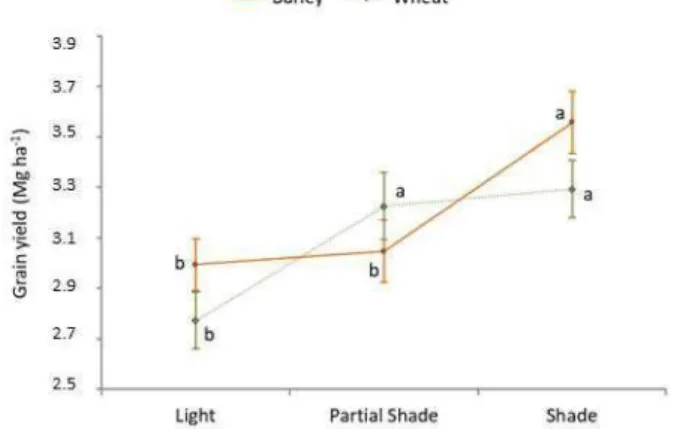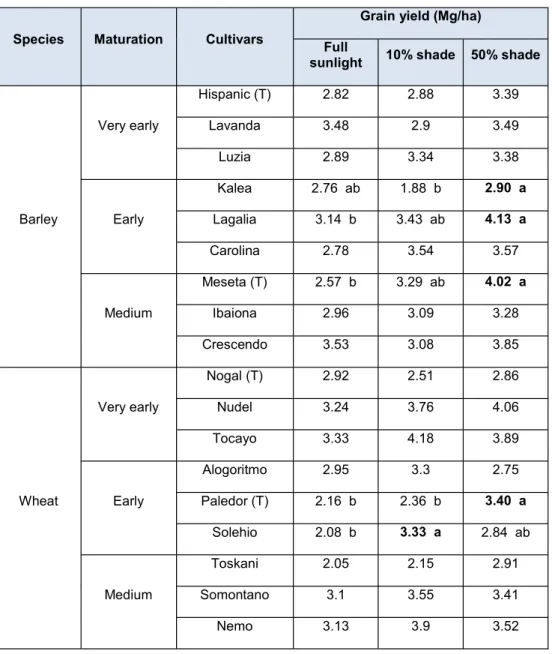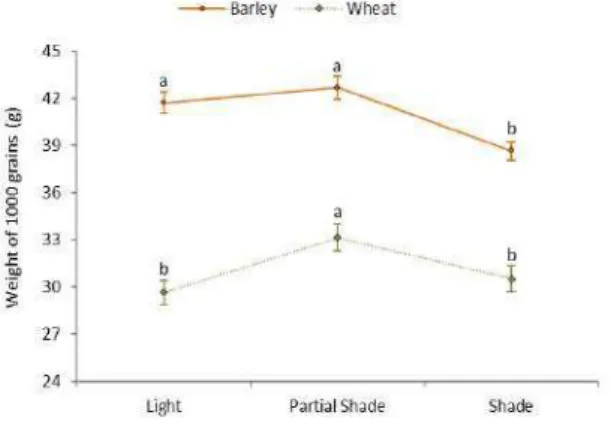127 4th European Agroforestry Conference Agroforestry as Sustainable Land Use
SHADE INCREASES CEREAL PRODUCTION IN
MEDITERRANEAN CONDITIONS FACING THE CLIMATE
CHANGE
Arenas-Corraliza MG1* - ML1, Moreno G1
*Corresponding author: garenascorraliza@unex.es
Abstract
A greenhouse trial with three levels of shade (0%, 10% and 50%) was performed in Mediterranean latitude to assess the influence of solar radiation intensity in the biomass and grain yield of winter wheat and barley. Nine cultivars of each species were studied and most of them, especially those of barley, increased their production under shade conditions. The quality of the grain in terms of N was also studied, and it was lower in the shade treatments in wheat compared to full sunlight, unlike barley, which did not experiment any change in N content in the different treatments. Our results suggest that tree shade in silvoarable systems could be a strategy of adaption to climate change, although a selection of cultivars adapted to shade is necessary to maximize the production of the system.
Keywords: barley; wheat; shade; silvoarable; climate change
Introduction
Throughout the second half of the twentieth century, crop yields grew up due to improved agronomic techniques, using of fertilizers, energy and pesticides and genetic selection and breeding (FAO 1996). These advances, known as "green revolution", allowed an increase in the crop yield per unit of cultivated soil by using high inputs (chemical and energy) and a small selection of crop species and cultivars, most of them adapted to full light conditions.
Despite the need to double food production in this century to feed the increasing human population, yields have stagnated in recent years. Decreases in crop yield are increasingly reported as a result of climate change and recurrence of extreme weather events (e.g. heat waves and long droughts) (Brisson et al. 2010; Ray et al. 2012). Brisson et al. (2010) showed that although genetic improvements are still being made to crops, this has been partly counteracted since the 1990 by climate changes which are unfavorable to cereals in temperate climates due to heat-stress during the grain filling phase and drought during stem elongation. Therefore, there is a need to design more productive and sustainable production systems. One approach is ecological intensification where the aim is to increase yield through a better use of (Cassman 1999 Bommarco et al. 2013). One approach is Agroforestry (Carsan et al. 2013; Tittonell 2014) since trees regulate the climate beneath them, reducing extremes of temperature, sheltering against wind and reducing evaporation from the soil surface. But most cultivars have been traditionally selected for full light conditions and that is why selection programs are needed to find cultivars adapted to partial shade.
Materials and methods
In 2016-2017, a greenhouse trial of winter cereal varieties was carried out at the Ecological and different cultivars of each winter cereal species (wheat and barley) to select those that showed
128 4th European Agroforestry Conference Agroforestry as Sustainable Land Use
a better behaviour under partial shade conditions for cropping in agroforestry systems. The seeds of these varieties were provided by the La Orden-Valdesequera Agricultural Research Institute, which collaborates with the Group for the Evaluation of New Varieties for Extensive Crops in Spain (GENVCE: http://www.genvce.org/). The nine varieties of each species were selected according to three categories of precocity (dates of sprout). These categories were: very early, early and medium.
Three treatments were established: full light with anti-bird net ("Light"), 10% shade ("Partial shade") and 50% shade ("Shade"). In each treatment a table was installed with six pots per variety, sowing four seeds in each pot (13 x 13 x 17 cm). On April 7, 2017 shading nets were introduced, coinciding with the leaf sprout of walnuts. The soil mixture was based on three parts of black peat, one part of sand and one part of perlite. Its soil water capacity was 119 % and pH was 5,8. All plots were fertilized in November with 58 kg ha-1 N, 100 kg ha-1 P
2O5 and 58 kg ha-1 K2O. In February, 200 kg ha-1 N were applied in each plot with urea 46 %. All plots were regularly irrigated in order to maintain soil water capacity above 50 % to exclude impact of soil water stress factor.
Results
In general, grain production increased with shade (Figure 1). While barley did not show an increase at 10% shade, it showed a significant increase at 50% shade. By contrast, wheat grain yields increased significantly from full sunlight to 10% shade and kept the same grain yield at 50% shade. Tables 1 to 3 show original data for different cultivars growing at different sinlight conditions (full sunlight, 10% shade, and 50% shade).
Figure 1: Grain yield (Mg ha-1) of barley and wheat in the different treatments: full sunlight (Light), 10 % shade (Partial shade) and 50 % shade (Shade).
Grain yield trend to be higher under 50% shade compared to full light for most of the barley Table 1). In wheat, the highest
grain yields were mostly found for 10% shade (Figure 1 Table
129 4th European Agroforestry Conference Agroforestry as Sustainable Land Use
Table 1: Grain yields (Mg/ha) for the cultivars tested in the different treatments: full sunlight (Light), 10 % shade (Partial shade) and 50 % shade (Shade).
Species Maturation Cultivars
Grain yield (Mg/ha) Full
sunlight 10% shade 50% shade
Barley Very early Hispanic (T) 2.82 2.88 3.39 Lavanda 3.48 2.9 3.49 Luzia 2.89 3.34 3.38 Early Kalea 2.76 ab 1.88 b 2.90 a Lagalia 3.14 b 3.43 ab 4.13 a Carolina 2.78 3.54 3.57 Medium Meseta (T) 2.57 b 3.29 ab 4.02 a Ibaiona 2.96 3.09 3.28 Crescendo 3.53 3.08 3.85 Wheat Very early Nogal (T) 2.92 2.51 2.86 Nudel 3.24 3.76 4.06 Tocayo 3.33 4.18 3.89 Early Alogoritmo 2.95 3.3 2.75 Paledor (T) 2.16 b 2.36 b 3.40 a Solehio 2.08 b 3.33 a 2.84 ab Medium Toskani 2.05 2.15 2.91 Somontano 3.1 3.55 3.41 Nemo 3.13 3.9 3.52
For barley, grain size (weight of 1000 grains) was slightly higher in 10% shade than in full sunlight (Figure 2
significantly in 50% shade. For wheat, grain size was significantly higher in 10% shade compared to 50% shade and full sunlight (Figure 2
130 4th European Agroforestry Conference Agroforestry as Sustainable Land Use
Figure 2: Weight of 1000 grains (g) of barley and wheat in the different treatments: full sunlight (Light), 10 % shade (Partial shade) and 50 % shade (Shade).
Barley had the same Nitrogen content in all treatments, slightly decreasing with shade (Figure 3). However, wheat experimented an important decrease in the shade treatment compared to full light (Figure 3) and
shade and shade respectively compared to full light.
Figure 3: Grain Nitrogen content (%) of barley and wheat in the different treatments: full sunlight (Light), 10 % shade (Partial shade) and 50 % shade (Shade).
Discussion
Grain yields were higher under shade, where maximum temperatures were buffered. This is especially important in years with dry/warm climate events in spring which constrain cereal yields. These extreme weather events are common in Mediterranean areas and are expected to increase in the next years as a consequence of the climate change. In the study, several May, when the flowering and grain formation of the cereal take place, could decrease the cereal yields in full light conditions. In fact, Romero and German (2001) indicated that at temperature In these conditions, shade could be a safeguard compared to light conditions, helping to maintain higher yields.
Shade appears to be more positive for barley than for wheat, presumably because of the earlier development of barley plants. In addition to being more premature, barley has a fast ripening and a short period of grain filling compared to wheat (Cossani et al. 2009). It is known that wheat is a full-light plant (Guerrero 1999), hence providing shade was not anticipated to improve the grain yield as it does in barley. In fact, in Mediterranean agrosystems, under unfavorable conditions (arid and/or low fertility), barley is prioritized over other cereals
-131 4th European Agroforestry Conference Agroforestry as Sustainable Land Use
Bellido 1992), since its precocity and rapid ripening have advantages in the use of water by avoid the common terminal stresses. Besides, the inclination angle of the leaves of barley and its foliage structure allows a greater interception of solar radiation (Muurinen and Peltonen-Sainio 2006), so it may be less sensitive than wheat to the possible negative effects of excessive tree shading. Barley seemed to not reduce its grain nitrogen content under any shade conditions, so the malting quality was maintained. However, in wheat, this contain was reduced in the shade treatment, which could deteriorate its flour for pasta and feed quality.
Conclusion
In general terms, slight shade did not reduce the production of cereals. On the contrary, it increased grain yields, especially in barley, in which, in addition, nitrogen content was not reduced with shade, unlike wheat. In this way, shade could be a way to mitigate excessive solar radiation in Mediterranean latitudes and high temperatures during the spike development and grain fill and increase yields. However, the effect of the shade depends on the cultivars and it is need to study its relation with other cereal stress factors (soil water deficit, nutrient content and phenology). Our results suggest the need of selection of cereal cultivars adapted to partial shade for implementation of silvoarable systems as strategy of adaptation to climate change. Besides, selection should not only be based on the optimal grain yield but also in functional traits indicative of important ecological processes such as water use efficiency and pest resistance.
References
Bommarco R, Kleijn D, Potts SG (2013) Ecological intensification: harnessing ecosystem services for food security. Trends Ecol Evol 28: 230 238.
Brisson N, Gate P, Gouache D, Charmet G, Oury FX, Huard F (2010a) Why are wheat yields stagnating in Europe? A comprehensive data analysis for France. F Crop Res 119: 201 212.
Carsan S, Stroebel A, Dawson I, Kindt R, Mbow C, Mowo J, Jamnadass R (2013) Can agroforestry option values improve the functioning of drivers of agricultural intensification in Africa? Curr Opin Environ Sustain 6: 35 40. Cassman KG (1999) Ecological intensification of cereal production systems: Yield potential, soil quality, and precision
agriculture. Proc Natl Acad Sci USA 96: 5952 5959.
Cossani MC, Slafer GA, Savin R (2009) Yield and biomass in wheat, and barley under a range of conditions in a Mediterranean site. F Crop Res 112: 205 213.
, -Jolain N, Tchamitchian M, Tittonell P (2011) Facing up to the paradigm of ecological intensification in agronomy: revisiting methods, concepts and knowledge. Eur J Agron 34: 197 210.
os, 6a. Mundi Prensa, Madrid.
-Bellido L (1992) Mediterranean cropping systems. In: Pearson CH (ed) Field Crop Ecosystems - Ecosystems of the World. Elsevier, pp 311 356
Muurinen S, Peltonen-Sainio P (2006) Radiation-use efficiency of modern and old spring cereal cultivars and its response to nitrogen in northern growing conditions. F Crop Res 96: 363 373.
Ray DK, Ramankutty N, Mueller ND, Wesr PC, Foley JA (2012) Recent patterns of crop yield growth and stagnation. Nat Commun. doi: 10.1038/ncomms2296


